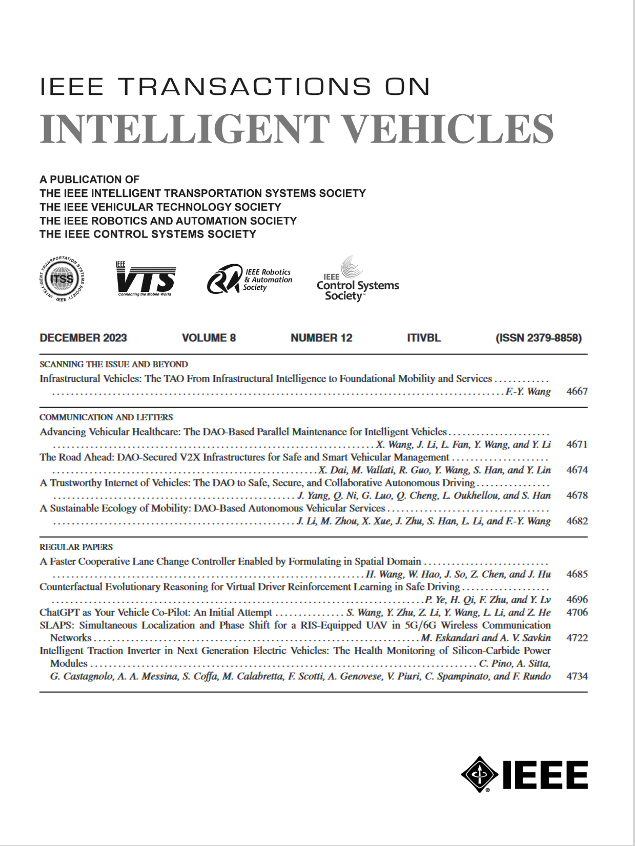Evaluation of Control Modalities in Highly Automated Vehicles: A Virtual Reality Simulation-Based Study
IF 14.3
1区 工程技术
Q1 COMPUTER SCIENCE, ARTIFICIAL INTELLIGENCE
引用次数: 0
Abstract
The integration of effective control modalities is paramount for enhancing user experience and safety in autonomous vehicles. This study investigates the performance and user experience of three control modalities i.e., voice, hand gesture, and physical button controls in high-level autonomous vehicles (Levels 4 and 5), under both distraction and non-distraction conditions. Our objective was to evaluate error rates, physiological responses, and subjective workload across these control modalities. The results revealed that distraction significantly increases error rates and perceived workload across all models. Voice control exhibited the lowest error rates without distraction but was most affected by it, whereas Hand Gesture control showed the highest error rates and workload in both scenarios. Physical Button control demonstrated moderate error rates and the least impact from distraction. Physiological data supported these findings, with significant increases in heart rate under distraction for all models, particularly in the voice control model. The NASA Task Load Index scores indicated higher workload under distraction, with hand gesture control being the most demanding. Our findings suggest that a combination of Physical Button and Voice control may offer the most effective solution, with recommendations for adaptive and multimodal interaction designs to mitigate distraction effects and enhance overall user satisfaction.高度自动化车辆控制模式评估:基于虚拟现实仿真的研究
有效控制模式的整合对于提高自动驾驶汽车的用户体验和安全性至关重要。本研究调查了高级自动驾驶汽车(4级和5级)在分心和非分心条件下的三种控制方式,即语音、手势和物理按钮控制的性能和用户体验。我们的目的是评估这些控制模式的错误率、生理反应和主观工作量。结果显示,在所有模型中,分心显著增加了错误率和感知工作量。在没有分心的情况下,语音控制的错误率最低,但受干扰的影响最大,而手势控制在两种情况下都显示出最高的错误率和工作量。物理按钮控制显示出适度的错误率和最小的干扰影响。生理学数据支持了这些发现,在所有模型中,注意力分散时心率都显著增加,尤其是在语音控制模型中。NASA任务负荷指数得分表明,分心时的工作量更高,手势控制的要求最高。我们的研究结果表明,物理按钮和语音控制的结合可能是最有效的解决方案,并建议采用自适应和多模式交互设计,以减轻分心效应,提高整体用户满意度。
本文章由计算机程序翻译,如有差异,请以英文原文为准。
求助全文
约1分钟内获得全文
求助全文
来源期刊

IEEE Transactions on Intelligent Vehicles
Mathematics-Control and Optimization
CiteScore
12.10
自引率
13.40%
发文量
177
期刊介绍:
The IEEE Transactions on Intelligent Vehicles (T-IV) is a premier platform for publishing peer-reviewed articles that present innovative research concepts, application results, significant theoretical findings, and application case studies in the field of intelligent vehicles. With a particular emphasis on automated vehicles within roadway environments, T-IV aims to raise awareness of pressing research and application challenges.
Our focus is on providing critical information to the intelligent vehicle community, serving as a dissemination vehicle for IEEE ITS Society members and others interested in learning about the state-of-the-art developments and progress in research and applications related to intelligent vehicles. Join us in advancing knowledge and innovation in this dynamic field.
 求助内容:
求助内容: 应助结果提醒方式:
应助结果提醒方式:


